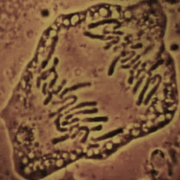Cell division is the mechanism by which DNA is passed from one generation of cells to the next and ultimately, from parent organisms to their offspring. Although eukaryotes and prokaryotes both engage in cell division, they do so in different ways. In particular, eukaryotic cells divide using the processes of mitosis and meiosis. Mitosis is common to all eukaryotes; during this process, a parent cell splits into two genetically identical daughter cells, each of which contains the same number of chromosomes as the parent cell. Meiosis, on the other hand, only occurs in eukaryotic organisms that reproduce sexually. During meiosis, the cells needed for sexual reproduction divide to produce new cells called gametes. Gametes contain half as many chromosomes as the other cells in the organism, and each gamete is genetically unique because the DNA of the parent cell is shuffled before the cell divides. This helps ensure that the new organisms formed as a result of sexual reproduction are also unique.
Unlike eukaryotes, prokaryotes (which include bacteria) undergo a type of cell division known as binary fission. In some respects, this process is similar to mitosis; it requires replication of the cell's chromosomes, segregation of the copied DNA, and splitting of the parent cell's cytoplasm. However, binary fission is less complex than mitosis due to the fact that prokaryotic cells have a simpler structure than eukaryotic cells.
This unit concentrates primarily on the two types of cell division used by eukaryotes. It begins by explaining the major steps involved in mitosis, and it next examines the major similarities and differences between this process and meiosis. The unit then explores recombination and mutation — two of the primary reasons why daughter cells don't always contain the same DNA as their parent cells.
















